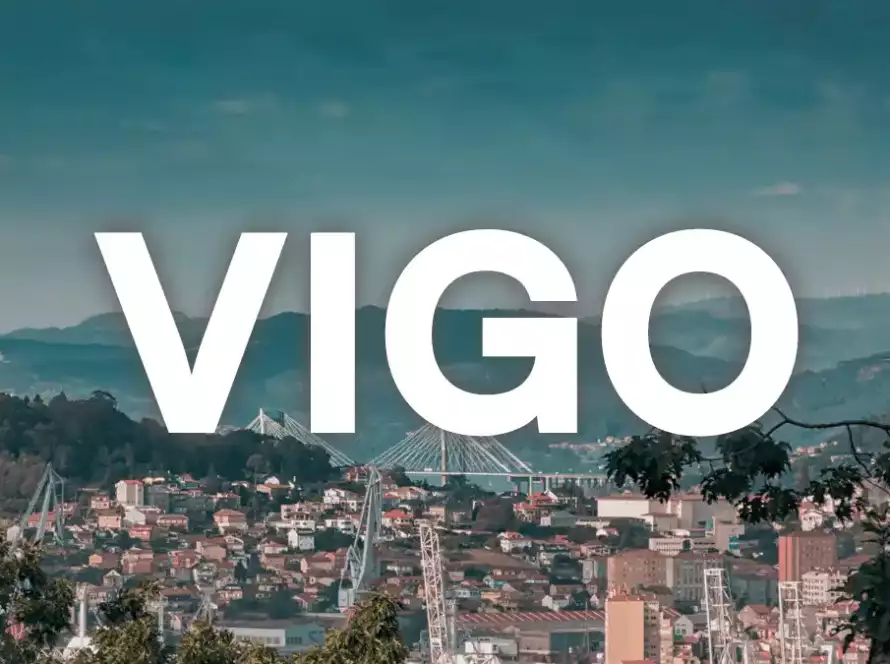Things to do in Berlin The German capital is a fascinating mix of history, avant-garde culture and vibrant city life. From the remnants of its divided past to its underground art scene, Berlin is a city that surprises at every turn. If you’re wondering things to do in Berlin, here we take you through its most iconic sights, alternative corners and unique experiences not to be missed.
Things to do in Berlin? More than a city, it is a living canvas where new stories are painted every day between walls that have seen the world change. They say that anyone who hasn’t strolled through Berlin at sunset, between historic monuments and urban art courtyards, hasn’t felt the true pulse of this indomitable capital.
Berlin captures you with its authenticity and its constant ability to reinvent itself. It is not just any destination, it is an experience that makes a mark and, as those who visit it know, always leaves you wanting to come back. Things to do in Berlin? Everything and nothing, because the important thing is not just to look, but to let yourself be carried away by its indomitable spirit. Do you dare to discover it?
⌛ STILL SEARCHING THROUGH BLOGS, OR WOULD YOU RATHER HAVE YOUR BERLIN GUIDE READY TO GO?
The DareMapp app makes it easy. Enjoy the FULL GUIDE ON YOUR PHONE and explore every corner in your own way — no schedules, no rush.
Things to do in Berlin. 10 must-see stops.
TV Tower.
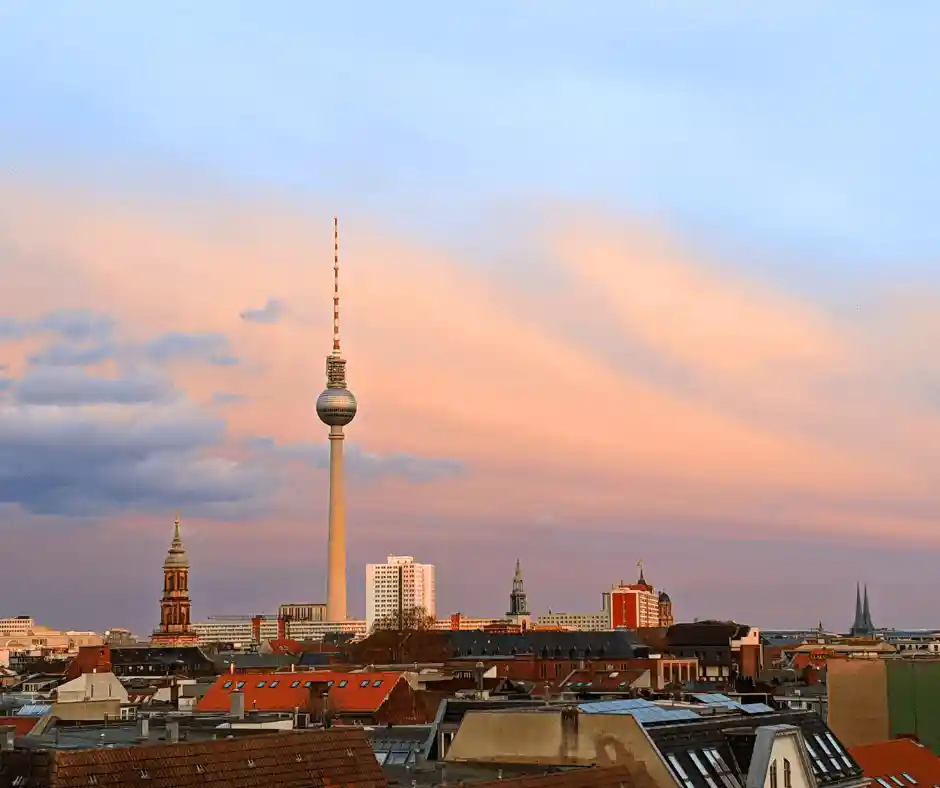
The Berlin TV Tower (Berliner Fernsehturm) is one of the most iconic sights to see in Berlin and an important symbol of the former East Germany. Opened in 1969, it stands 368 metres high, making it the tallest structure in Germany and the second tallest in the European Union. Its construction was part of the GDR (German Democratic Republic) government’s efforts to demonstrate the power and technological advancement of the socialist regime.
The tower is located on Alexanderplatz Square in the heart of Berlin, making it a key landmark for tourists and locals alike, and one of the greatest things to do in Berlin. You can access it by buying a ticket at this link.
Curiosities.🔎
- During the Cold War, the TV Tower was considered a symbol of socialist superiority, and the image of the tower with the sun reflected in its sphere became a propaganda icon.
- A curious fact is that the TV Tower was used to transmit television signals, but also as a tool for political communication.
- At one time, the tower’s metal sphere reflected the sunlight so intensely that people in East Berlin called it “the ball of capitalism”, due to the perception that the sun was shining on it from the west.
- Despite its propagandistic use in the GDR, today it is a popular tourist site that attracts thousands of visitors each year, who can enjoy the spectacular views and modern ambience of its facilities.
Karl Liebknecht Bridge
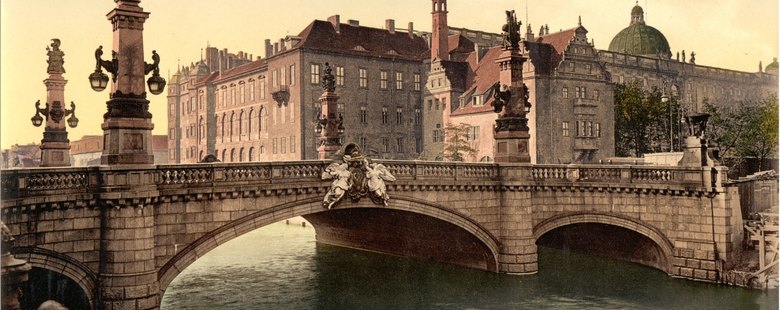
The Karl Liebknecht Bridge is an iconic bridge spanning the river Spree in Berlin, known not only for its functional importance, but also for its historical significance. Its construction began in 1955 and was completed in 1957, during the era of the German Democratic Republic (GDR), making it one of the most significant infrastructures to see in East Berlin. The bridge connects the Mitte district with the Friedrichshain district, crossing one of the city’s main waterways.
Its name pays homage to Karl Liebknecht, a prominent German socialist and revolutionary leader, who played a key role in the events of the German Revolution of 1918 and the founding of the Communist Party of Germany (KPD). Over the years, the bridge has been a key part of Berlin’s infrastructure, being one of the main transport routes connecting historic areas of the city. Today, the Karl Liebknecht Bridge is one of the key sights to see in Berlin and stands as a testament to post-war Berlin and the division of the city, reflecting the imprint of the socialist period in its structure and symbolism.
If you’re wondering things to do in Berlin, this bridge offers one of the best panoramic views of the Spree River and surrounding areas, making it a perfect stop to capture some photos of the city.
🐻 Have you ever wondered why there are so many bears all around Berlin? What do they really mean?
With the DareMapp app, enjoy a COMPLETE SELF-GUIDED TOUR ON YOUR PHONE and discover this and many other curiosities as you explore the city.
Berliner Dom. Cathedral
The Berliner Dom, or Berlin Cathedral, is one of the most impressive sights to see in Berlin. Located on Museum Island, near the river Spree, this majestic church is an emblem of baroque art and architecture in Germany. Its construction began in 1894, and its impressive 98-metre-high dome dominates the Berlin skyline, offering a spectacular view.

One of the most fascinating features of the Berliner Dom is its architecture. The dome is surrounded by a series of neo-baroque elements that give it a sense of grandeur and solemnity. The interior of the church is equally dazzling, with an impressive arrangement of marble, gold and stained-glass windows, including details from biblical history.
In terms of curiosities, the Berliner Dom is not only a place of religious worship, but also a place of great history. During World War II, the cathedral was badly damaged by bombing, but was restored between 1975 and 1993. An interesting detail is that, despite being the largest cathedral to see in Berlin, it is not the seat of the archbishop, as Berlin belongs to a Protestant diocese.
Things to do in Berlin is not complete without a visit to this building, as inside you can explore its crypt, where important figures of Prussian history rest, such as the Hohenzollerns, one of Germany’s most influential dynasties. You can also climb the dome to enjoy panoramic views of the city.
Museum Island
Museum Island (Museumsinsel) is one of the most iconic places to see in Berlin for any visitor. Located in the centre of the city on the River Spree, this small island is home to an impressive concentration of world-class museums, all of which are UNESCO World Heritage Sites. If you’re wondering things to do in Berlin, the Museum Island is definitely a must-see destination.
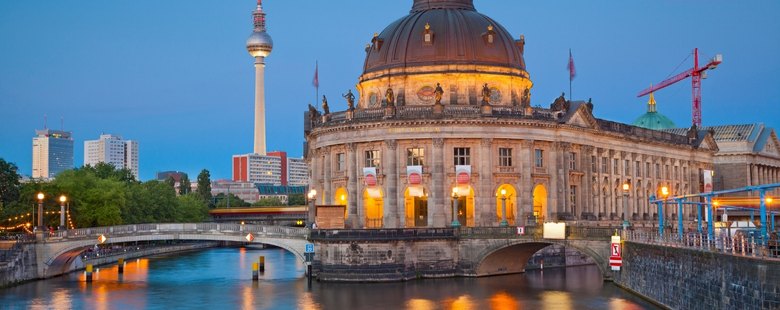
Highlights include the Pergamon Museum, famous for its monumental Pergamon Altar and Ishtar Gate; the Bode Museum, which houses an impressive collection of medieval art; and the Altes Museum, which exhibits one of the finest collections of ancient art in the world. Each of these museums offers a unique experience, full of history, art and culture. In addition, you can visit the Neues Museum, which houses the famous bust of Nefertiti, one of the most renowned pieces of ancient Egyptian art.
Things to do in Berlin is not complete without exploring this island, as in addition to its enormous cultural wealth, it is a perfect place to enjoy quiet walks along the river and marvel at the architecture of the museums, built between the nineteenth and early twentieth centuries. Without a doubt, the Museum Island is one of the richest places in the city in terms of history and culture.
If you are looking for a complete experience in Berlin, the Museum Island offers you not only the opportunity to see art from all periods, but also to immerse yourself in the history of the city, from antiquity to the 19th century. It’s the perfect place for those interested in history and culture, and is a must-see on any tour of the German capital.
Bebelplatz
Bebelplatz is one of Berlin’s most iconic squares, located in the heart of the city, close to the famous Unter den Linden. This historic square is known not only for its architectural beauty, but also for the historical events that have taken place here. If you are wondering things to do in Berlin, Bebelplatz is an essential place to learn more about German history, especially because of its connection to the Nazi regime.
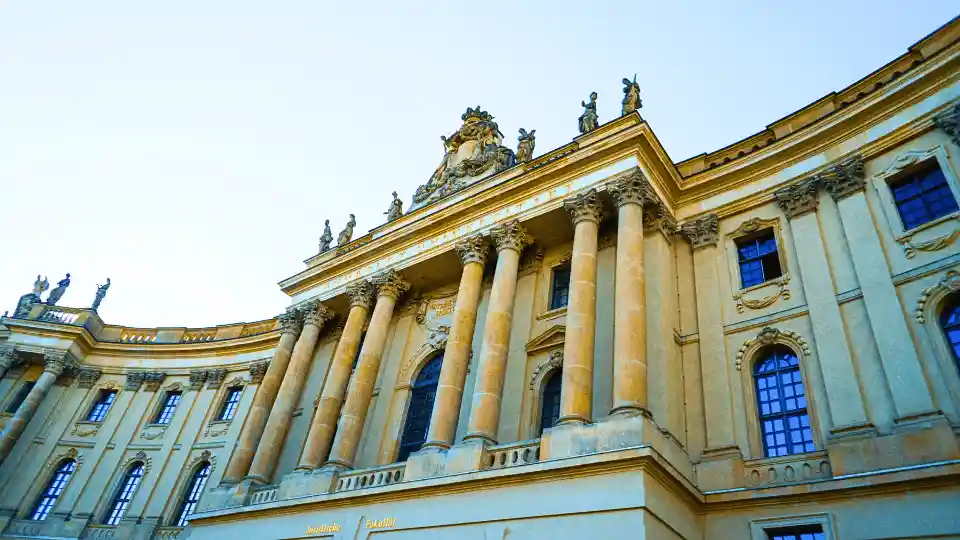
One of the most tragic moments that took place on Bebelplatz was the 1933 book burning, a symbolic act carried out by the Nazis to eliminate books considered “un-German” or contrary to the regime. Here, on the night of 10 May 1933, students and members of the Nazi regime threw books into the flames, marking a dark chapter in the history of intellectual freedom.
As a tribute to these events, in the centre of the square is a unique installation: a glass window overlooking an underground vault filled with empty books, a silent reminder of the damage caused by censorship. If you’re wondering things to do in Berlin, this is a place to reflect on the importance of freedom of expression and human rights.
A stroll through this square is a journey not only through history, but also through the city’s architectural legacy. Things to do in Berlin is incomplete without visiting this place, as the square is not only a historical landmark, but also a space that invites reflection on collective memory.
Twin Cathedrals
Berlin’s Twin Cathedrals, known as Deutscher Dom and Französischer Dom, are two impressive religious monuments that represent different styles and periods in the city’s history.
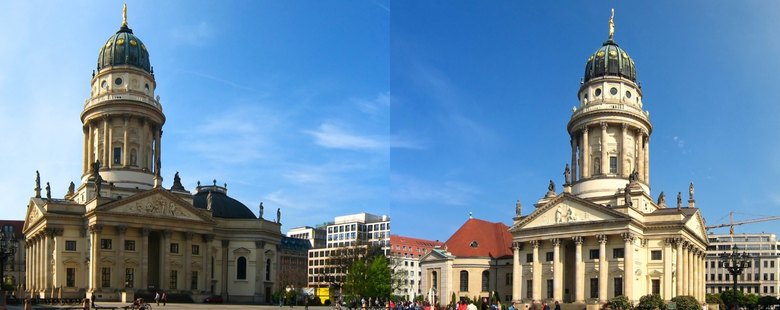
We move on to Gendarmenmarkt, considered to be Berlin’s most beautiful square. Designed and built in the 17th century as the urban centre of the city, one of its main attractions is the presence of two visually ‘almost’ identical cathedrals at opposite ends of the square.
Both have a similar appearance due to their towers, but they originate from the coexistence of two religious communities in the 17th century: the French Huguenots (Protestants who were persecuted in France and moved to Berlin in search of refuge) and the German Lutherans.
And how was it possible to build two churches in the same square, and almost identical ones at that? Well, King Frederick I of Prussia had a great idea: to integrate French immigrants, he allowed both communities to build their churches in the square, as long as they coexisted in harmony.
Its equally grandiose interior is decorated with detailed frescoes and beautiful stained glass windows, making the visit a journey through Berlin’s religious and cultural history.
Things to do in Berlin is not complete without a tour of this cathedrals, as they have part of the story: the Huguenot Museum (which tells the story of this community) and the Museum of Parliamentary History.
St. Nicholas Cathedral
On the other hand, St. Nicholas Cathedral is located in the Nikolaiviertel district, the heart of medieval Berlin. It is one of the oldest churches in the city, originally built in the 13th century and restored after World War II. This Gothic-style church is more modest compared to the majestic St. Peter’s Cathedral, but its quiet atmosphere and red brick façade give it a special charm. The cathedral was restored as a place of worship and also houses a museum dedicated to the history of medieval Berlin.
If you’re wondering things to do in Berlin, this is a fascinating place to see what the city was like in its early days.
Both cathedrals, though very different in style and function, represent two crucial moments in Berlin’s history: the splendour of its imperial heyday and the city’s medieval legacy. Visiting both allows you to get a more complete picture of Berlin’s religious and architectural evolution. They are definitely Berlin must-sees on any city tour.
💡BERLIN IS FULL OF PLACES THAT SHAPED EUROPE’S RECENT HISTORY — THE WALL, THE REICHSTAG, CHECKPOINT CHARLIE…
With the DareMapp app, explore each of these key sites and uncover what really happened through essential facts and stories — all on your phone.
Checkpoint Charlie
Checkpoint Charlie is one of Berlin’s most iconic Cold War landmarks and an essential place to understand the city’s history. This former border checkpoint was the main crossing point between East and West Berlin during the division of Germany from 1961 to 1990. Checkpoint Charlie became a symbol of the tension between the Western and Soviet blocs, representing both the physical and ideological division of the city. If you’re wondering things to do in Berlin, this place has great historical value and is one of the most significant stops on any tour of the city.
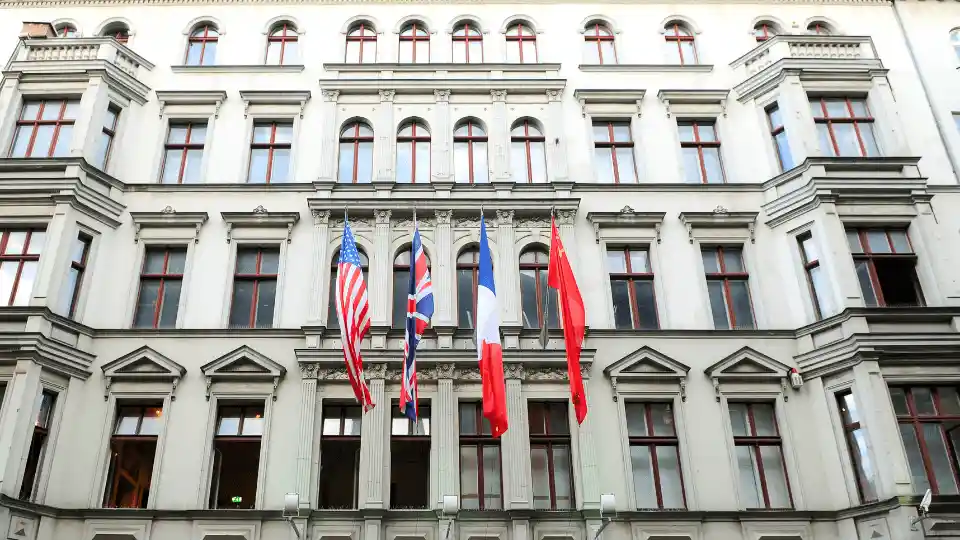
The name Checkpoint Charlie comes from the letter C in the NATO military alphabet, as there were other checkpoints with similar names, such as Checkpoint Alpha and Checkpoint Bravo, representing different border crossings between East and West Germany. The famous sign reading “You are leaving West Berlin” was a constant reminder of the division of the city.
Today, Checkpoint Charlie is an open-air museum that offers a fascinating insight into the history of the Cold War, with exhibits on the escape attempts of citizens from the East to the West, and historical documents recounting the most tense moments of the war. A replica of the original checkpoint can also be seen here, as well as a representation of the soldiers who guarded the checkpoint. If you’re looking for things to do in Berlin, you can’t miss this stop to understand the effects of the division of the city, life under communist rule and the stories of bravery of those who tried to escape to freedom.
In addition to its history, Checkpoint Charlie is close to other Berlin landmarks such as the Berlin Wall and the Topography of Terror, making the area a key historical centre. A symbol of the end of the Cold War and German reunification, visiting Checkpoint Charlie is a way to connect with a pivotal period in contemporary history.
Berlin Wall
The Berlin Wall is one of the most powerful and tragic symbols of the Cold War, and its history is deeply linked to the division of Germany and the conflict between the East and West Blocs. Initiated in 1961 by Democratic Germany (GDR), the wall was built to stop the mass emigration of East Berliners to West Berlin, who were fleeing the communist regime in search of a better life. Things to do in Berlin is not complete without understanding the impact this wall had on the city and the world.
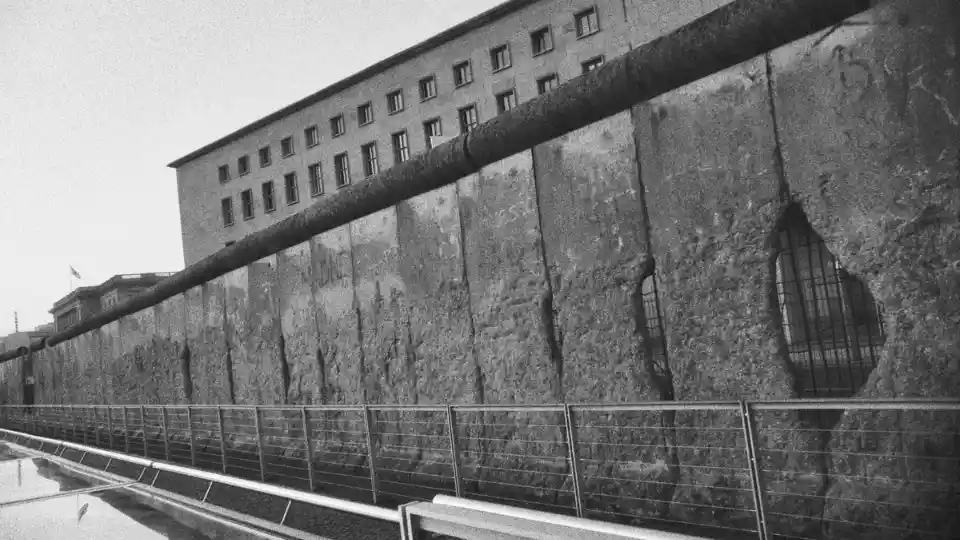
Stretching 155 kilometres, the wall physically separated Berlin into two parts, becoming a symbol of the division of Europe and the world during the Cold War. Throughout its 28 years of existence, the wall was an impenetrable barrier, with watchtowers, barbed wire, and a death strip between the two sides, where people trying to escape from the East often lost their lives.
Today, things to do in Berlin includes several points of the former Berlin Wall, which have been preserved as a reminder of history. One of the most significant sites is the East Side Gallery, a stretch of wall that has been transformed into an open-air gallery, with murals reflecting freedom and hope after the fall of the wall in 1989. This gallery is one of the largest open-air art exhibitions in the world and a place of reflection on the political and social changes that took place in Berlin.
In addition, the Berlin Wall can be explored at the Berlin Wall Memorial near Bernauer Strasse, where a number of original sections of the wall have been preserved, as well as an information centre explaining its history and the consequences of the division of the city. Visiting this site is a powerful way to understand the realities of German division and how the fall of the wall in 1989 marked the end of the Cold War and the reunification of Germany.
The Berlin Wall is undoubtedly a crucial place to understand things to do in Berlin and recent European history, a reminder of the struggle for freedom and unity in a time of sharp political divisions.
Brandenburg Gate
The Brandenburg Gate is one of Berlin’s most iconic monuments and a symbol of the city, German reunification and European history. Built between 1788 and 1791 by the architect Carl Gotthard Langhans, this neoclassical gate was commissioned by King Friedrich Wilhelm II of Prussia as a symbol of peace. Originally, the Brandenburg Gate served as one of the gateways to old Berlin, standing on Pariser Platz on the western side of the city.
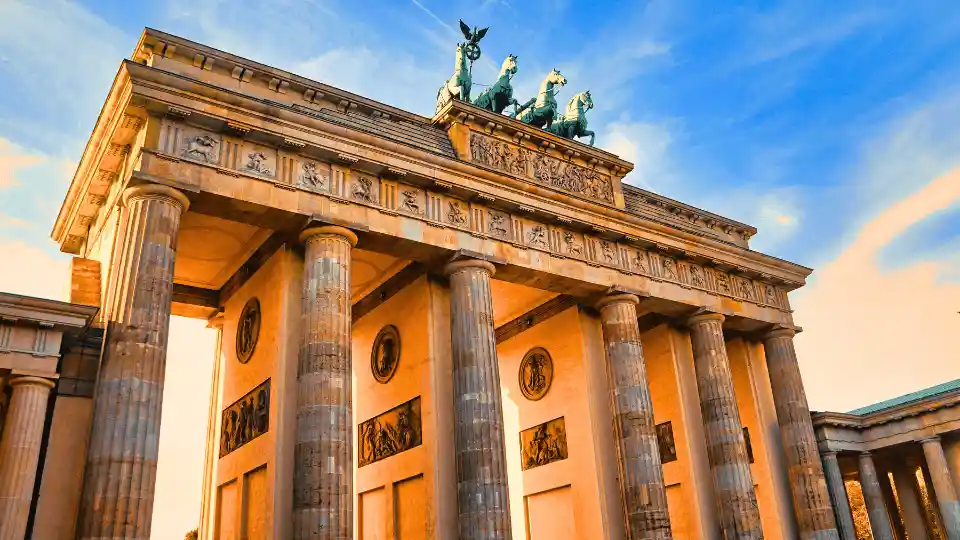
What makes the Brandenburg Gate especially significant in Berlin’s history is its location and the events surrounding it. During the Cold War, the gate became a symbol of the division of the city. It was located right on the demarcation line between East and West Berlin, making it one of the most iconic sights to see in Berlin. This location meant that for decades the gate remained closed and inaccessible to Berliners, a sad reminder of the separation between the communist and capitalist blocs.
If you’re wondering things to do in Berlin, the Brandenburg Gate is an obligatory stop to reflect on this historical period and the struggle for the reunification of Germany.
The gate, built in neoclassical style, has twelve columns forming five passages, the central one of which was intended for Prussian royalty. At the top of the gate is a quadriga, a figure representing the goddess of victory, which was originally looted by the French during the Napoleonic Wars, but was returned in 1814, symbolising the restoration of Prussian peace and power.
In 1989, with the fall of the Berlin Wall, the Brandenburg Gate became a potent symbol of German reunification. Thousands of people gathered there to celebrate the end of the division, and today, the gate remains a place of meeting and celebration in Berlin. It is a witness to the passing of history, a place of peace and unity, and an essential stop if you are looking for things to do in Berlin.
Today, the Brandenburg Gate stands as one of the city’s most visited landmarks, surrounded by a vibrant area of cafes, shops and events. It is also close to other points of interest such as the Reichstag (German parliament) and Tiergarten Park, making it the perfect place to start or end a tour of Berlin.
Reichstag
The Reichstag is one of the most iconic buildings to see in Berlin and a symbol of Germany’s political history. Built between 1884 and 1894, this imposing building was originally designed to house the Imperial German Parliament. Its neoclassical architecture, with a majestic glass dome, makes it one of the most recognisable structures in the city. If you’re wondering things to do in Berlin, the Reichstag is an essential place to understand modern German history, as it has witnessed crucial events over the centuries.
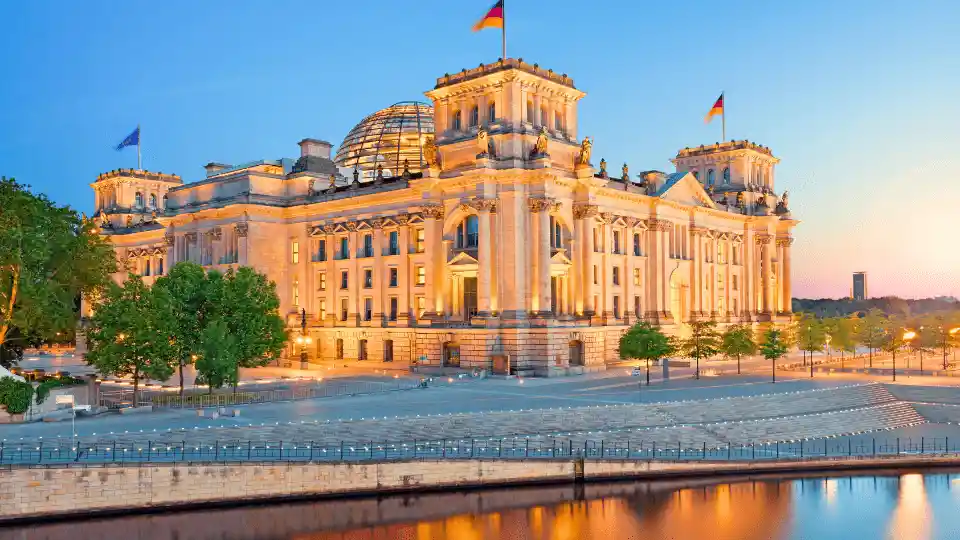
One of the most significant stages in the Reichstag’s history occurred in 1933, when a fire, still mysterious today, destroyed a large part of the building. This event was used by the Nazi regime to justify the suppression of civil liberties in the country, ushering in an era of oppression. After World War II and the division of Germany, the Reichstag stood in West Berlin, but was a symbol of divided Germany. Things to do in Berlin would not be complete without remembering how the building became a key landmark during the Cold War.
The Reichstag became part of reunified Germany after the fall of the Berlin Wall. In 1999, the building was restored and modernised by architect Norman Foster, who designed the famous glass dome that crowns it. Today, this dome offers a breathtaking panoramic view of Berlin and allows visitors to walk around its circular platform, while learning about German political history through informative exhibits.
As well as being the seat of the Bundestag, the German Parliament, the Reichstag is also a symbol of German democracy. Things to do in Berlin is not complete without a visit to this building, as it is not only a testament to German history, but also a place that represents the unity and continuity of the nation after decades of division.
💫 You’re just one click away from turning reading into adventure.
🗺️ Your route through Berlin, with DareMapp
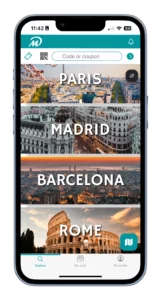
Tips to travel with peace of mind
When everything is ready — flights, hotel, itinerary — there are only two more things you need to travel worry-free: a good internet connection and reliable travel insurance.
✔ Get an international eSIM already set up on your phone. No need to change your SIM card, search for Wi-Fi, or pay for roaming. Activate it before your trip and enjoy unlimited data from the very first minute, wherever you are.
✔ Take out travel insurance that includes medical assistance 24/7, coverage for cancellations, theft, and — most importantly — advance payment of all medical expenses without you having to pay, wherever you are. Because in a new country, what matters most is feeling safe. Moreover, DareMapp offers you a 5% discount.
Both services can be arranged online in less than 5 minutes, with no paperwork required.
Don’t leave it to the last minute!
👉 Activate your Holafly eSIM at the best price here.
👉 Take out your travel insurance with IATI and get a 5% discount.
If you decide to visit the Reichstag, it is advisable to do so in advance to gain access to the dome, which is free of charge, but requires a reservation for security reasons. By touring the building and its dome, you will have the opportunity to reflect on the historical events that shaped the destiny of Germany and, by extension, Europe.
We hope this guide to Berlin’s must-see attractions will help you discover the magic of the “City of Freedom”. But if you want to experience it to the fullest, don’t miss the DareMapp app!
With it, you’ll have everything in one app:
✅ Route through Alexanderplatz, Museum Island or Gendarmenmarkt, among other points.
✅ Local recommendations (the best cafés, breweries and the most important dishes).
✅ Excursions and fun activities in nearby towns.
nightlife plans (speakeasy bars, jazz clubs and more).
All the things to do in Berlin and much more at your fingertips and from your mobile. Download it for free here!
Berlin is an open book of history, art and magic. We hope this guide of things to do in Berlin will inspire you to explore it with the eyes of a curious traveller
Remember that with DareMapp you can take a multitude of interactive guided tours, including many of these “European most famous routes” for fun sightseeing around the main destinations.
What better way than to travel and discover while learning in a fun way?





